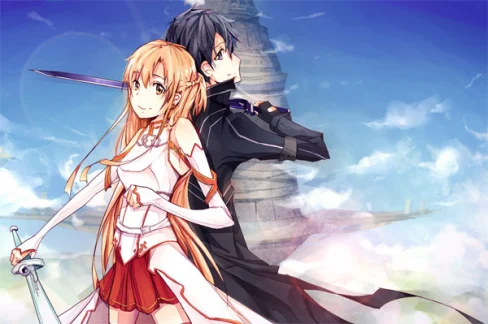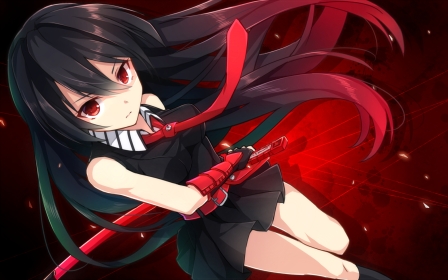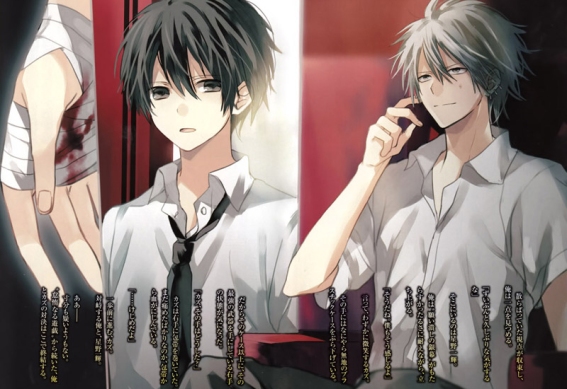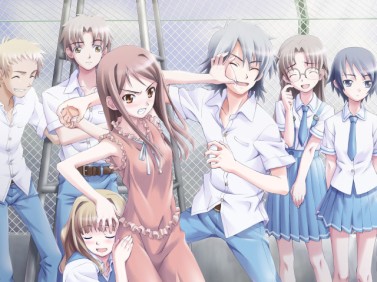I decided to write down my top 15 overall works of fiction and why I love them so much! Keep in mind this is my personal list, I’m not attempting to make a critical or objective list at all. Also, I won’t write a whole lot about each of them, mainly because I plan to write an appropriate review/reaction for each of them at some point, this is just to list the works and why I like them in a nutshell.
//———————————————————————
#15 – Sharin no Kuni, Himawari no Shoujo
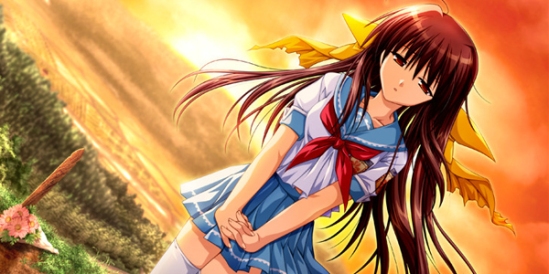
This was my first AkabeiSoft 2 visual novel, and the reason why I went for it almost two years ago was because I tend to like works that discuss alternate forms of society and/or government, so when I read that this work had an original social structure that was well explored, I immediately decided to check it out. I got more than I was expecting from it though, since not only did I like the social critique aspect of it, but I also liked the way the characters were developed, specifically Kenichi, the main character. The themes of the story, which involved mainly friendship, family and what society really means, were right up my alley, and I found myself entertained by the story at all times. Plus it made me think, which gave it a purpose, something that any favorite of mine has to have.
Now, the individual chapters didn’t really contribute to the main plot, in the sense that they were all about the heroine in question, but we always get to see and learn something new about this distorted system, and fortunately all the heroines play a role, even if not as relevant as Kenichi, in the final chapter, so they don’t feel wasted. It’s the most consistent work in this list because I never got bored of it, and I thought its quality was really good throughout its entire duration. This also means that it never peaked as high as some of my other works in this list, hence its “low” position. The main heroine Natsumi also contributed a lot to my love for Sharin no Kuni, as her personality and past with Kenichi are extremely well done, and I could feel the change in her after Kenichi went back into her life, and they make a great canon pair. All in all, it was a work with great themes and characters, and one that I’d recommend to anyone because it’s a relatively short and easy read.
//———————————————————————
#14 – Ace Attorney / Gyakuten Saiban

I’ve played my fair share of story-driven games over the years, but none was as appealing to me as Ace Attorney. I came upon it when I was looking for a way to pass time during the Summer of 2011, and I instantly got hooked. The characters were very believable, the comedy was on point and the gameplay was really engaging. I found myself playing all of the games, including the spin offs, during that Summer, and it was quite the experience. While not as loaded with themes as some of my other works in this list, its execution is what carries it: it manages to blend drama with comedy without one disturbing the other, and it does a great job making you attached to the main characters. The gameplay is all about finding clues and then defending your case in court, using said evidence, to successfully save the life of your client.
Specifically, what makes Ace Attorney my favorite story-driven game is Edgeworth’s character. He starts out as someone who lost his way and is involved with a lot of corruption, going as far as to make innocent people receive the guilty veredict, despising criminals above everything else. Once you learn why he became this way, his character becomes really good, and he has his own spin offs where he’s fleshed out even further. Another character that made the games so good was Maya, who is Phoenix’s sidekick. A bit slow but always reliable, Maya is always there for Phoenix, and she’s saved his butt many MANY times, and has been saved by him just as many. Their relationship isn’t at all romantic or anything, but they work extremely well together, not to mention they have some of my favorite comedy moments in fiction. Ace Attorney works so well because it takes the time to flesh out its characters and provide enough clues so you can deduce who the criminal was, and it never feels asspulled or rushed, and that’s why it deserves a spot in my list.
//———————————————————————
#13 – Air, the 1000th Summer

Key is one of my favorite sources of drama, and Air is one of its finest works. It was the last Maeda work I watched, and I really didn’t like the anime all that much, but around 6 months later I went for the visual novel, since it had finished being translated. What makes it stand out from the rest as soon as you read the plot is that there is no school the main character goes to, nor is there any of the common tropes you find in other works of the same studio. Instead, it starts out very plot-driven, with the main character Yukito setting out on a journey to find a “girl in the sky”, having been told by his mother that he was destined to find her. It soon begins to show some of said tropes, but it feels very different. There is a low number of heroines, and only one matters in the overall course of the story, but that’s what allows it to focus so well on that heroine, and on the main character.
Another thing that Air has going for it is that it connects a story that happened a thousand years ago, like the title implies, with the present story, and it does so by fully showing the events of both stories in their appropriate routes. The final route is the conclusion of both these stories, and is the main reason why it’s so acclaimed. The drama is very well handled, and it’s the only Maeda work that doesn’t end on a completely positive note, which actually surprised me because every other work of his had some sort of ending where everything was fixed, but not Air. The side routes are unimpressive for the most part, but Minagi’s stands out as one of Key’s best heroine routes, and is worth the shot even if you decide for whatever reason to skip the others. The execution and time spent on the main characters were what made it work, and the lack of those was what made the anime fail miserably. Granted, the story is a bit slow and the artwork will scare some people off, but if you see past those problems, there’s a really beautiful story waiting for you, and one that will teach you the importance of human bonds.
//———————————————————————
#12 – Legend of the Galactic Heroes

It’s the oldest entry in this list by far, and it’s also the one I consider to be the most difficult getting into. I watched it in 2014, when I felt I could finally get into it, and it became one of my favorite works even before I finished it. LOGH is a work that’s all about politics, history and warfare, and to develop such themes, it uses one of the most powerful casts there are in fiction. Its lore is very interesting by itself, and the show actually uses a couple of episodes to fully explore this lore, much like something like Shinsekai Yori did, and while that might seem like infodump, it was done in a way that will make you appreciate the effort spent on it.
Usually in these “battle of wits” shows (such as Code Geass or Death Note), you’re going to pick a side early on, and to me LOGH was not an exception; however, unlike the others, I actually questioned the side I picked A LOT throughout the show, because of how well it presented both sides. On one hand, there’s the democratic alliance, on the other there’s the galactic empire. As if the conflict being extremely grey wasn’t enough, the characters that “represent” each of the sides are superb in terms of writing and personality, and it’s extremely easy to get attached to both of them after a while. It uses its long length to also develop its side cast quite a bit, and at the same time it manages to develop an incredible amount of themes without losing track of what it’s doing, being the best time management I have ever seen. If you are into politics or history, LOGH is a work you’re going to appreciate and hopefully enjoy. The reason why it’s not higher despite all my praise is simply because there were some boring parts, and the last season was not as good as the one that came before, though the ending was magnificent.
//———————————————————————
#11 – Kono Oozora ni, Tsubasa wo Hirogete

This might seem like a weird choice, taking into account my list so far. However, KonoSora’s light drama and very realistic approach on having a common goal with friends was absolutely fantastic. At this point it’s been almost a year since I’ve read it, but I still remember it as if I read it yesterday. Its first scene captured my attention right away, because of how beautiful it was. What followed was a slow yet very rewarding story that had the main character Aoi and 3 of his friends building a Glider to soar through the skies, particularly through a phenomenon called “Morning Glory” that’s very rare and only happens at the end of the Summer. It’s a slice-of-life work that doesn’t really offer anything new to the genre, but the execution of… pretty much everything was really good. It uses the simplest plot possible and, thanks to the well written cast, turns it into a story that will make you emotionally engaged to the dream that the characters share.
It has some scientific explanations about how aerodynamic stuff works, which admittedly do get a bit repetitive and sometimes slow down the story, but I found them to be interesting because it allows me to better understand what the characters are doing. They fail multiple times, and they never make the same mistake twice, showing that they learn through experience. At one point Aoi remarks on how much they changed since the time they started building the glider, showcasing the changes in the mentality of the characters as well. All the routes have the same ending, but it’s achieved very differently, and of course Aoi ends up with a different heroine in each of them. It’s one of the few works where I have difficulty saying who the best heroine is, because honestly all of them are really good. Unfortunately, the work suffers from a really awful official translation, and that will put off some people. I recommend reading it with the restoration patch, which not only restores the H-scenes, but also improves the quality of the dialogue, making the experience much closer to the original one.
//———————————————————————
#10 – My Girl

The family theme is one that almost always seems to get me, and My Girl is an example of this. I read it because I was trying to find a work that could get me into the manga medium. It ultimately failed to do that, but what I got was far more valuable. It’s a relatively short manga about a guy who finds out he has a daughter and decides to live together with her. The hardships of being a parent will make you extremely emotional, to the point where it might even draw some tears, and as if that wasn’t enough, Koharu’s perspective on the whole thing, even being a child, is extremely helpful as well. It feels like Masamune learns as much with Koharu and she learns with him. It never got boring or repetitive, which surprised me because that was my problem with Usagi Drop, and the reason why I didn’t like it as much as some other people did. My Girl teaches you a lot about what being an adult means, taking responsabilities and being a parent, and then it also shows the childhood story of Koharu, making it even more rewarding.
Presentation of themes is extremely important in any work, meaning that even if the themes are good or up my alley, if they are shown in a crappy way, there’s no way I’ll like them. My Girl nails this because it uses its side cast really effectively to develop both the main characters and showing their personal struggles. Considering I dislike manga, My Girl acomplished something that hasn’t happened much: it actually made me shed a tear or two at some poits. Its beauty is in the fact that the characters learn to live with one another, they learn to respect each other, they grow because of that. And I really FELT that growth. With this, My Girl is the only work in the manga medium that made it into this list.
//———————————————————————
#9 – Fate/Series
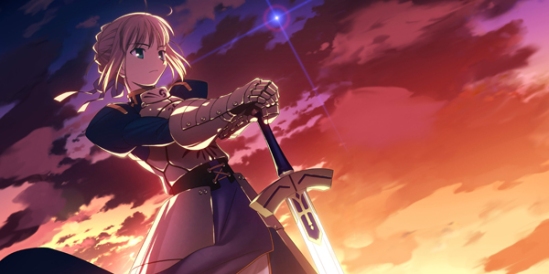
There are many works that try to use the “death game” genre and end up being a mess, like Future Diary. In fact, most of them are straight out bad. However, Fate does things a little different. In both Fate/Zero and Fate/Stay Night, there’s much more than just the death game; it’s all about the characters. Whether it’s the constant ideology discussions or the character exploration going on, Fate always finds a way to impress me. Now to clarify, I dislike every attempt that has been made so far to adapt F/SN, this includes the more recent Ufotable one, because they always manage to ruin the main characters by not giving them the necessary scenes or monologues, and then they come off as stereotypical characters (looking at you anime Shirou and anime Rin…). Either way, starting with Fate/Stay Night, the visual novel impressed me on the grounds that it kept developing Shirou as this character who is “broken” because of his past and ends up doing everything for everyone as a way to punish himself, even if he is unaware of this. The way F/SN does this concept justice is by having two different routes, Unlimited Blade Works and Heaven’s Feel, where there are two different choices that Shirou makes. In one, he will continue to follow his ideal of becoming a champion of justice even after witnessing where he might end up, in the other he abandons it for the his own happiness. The way this is done is superb, and along with the smart writing in both routes, it’s what makes Fate/Stay Night such a good work for me.
Though for different reasons, I like Fate/Zero just as much. F/Z deals with its characters in a more mature way, for starters, and it has many different topics it explores like “What does it mean to be a king?” or “Is honor a foolish concept?”. Each character represents an ideology, and that’s the advantage of using historical figures. By giving them the beliefs they had when they lived, we can see people with different concept of what being a leader means, like Alexander the Great and King Arthur, having an open discussion about it. It’s really interesting, though some people might be bored and think of it as mere infodump. There’s also the fact that Kiritsugu is one of my favorite main characters, due to how well his ideals and past are explored. The series is great overall, and I really wish F/SN got a proper adaptation, though that is most likely never going to happen. It’s the only death game work of fiction that I think is genuinely amazing and deserves its reputation.
//———————————————————————
#8 – Cross Channel

A controversial work to say the least, I never planned to read Cross Channel at all, due to the stuff I had heard about it. However a friend started reading it and he really liked it, so I went for it to see if I’d enjoy it, and it was quite the experience. Cross Channel is like Evangelion in the sense that people’s reactions to it are very varied, as the main characters, while very well written, are very hard to like. I’d say Taichi, CC’s main character, is more likable than Shinji, but that’s only if you can go through the first chapter of the visual novel, which is absolutely horrible. It’s basically Taichi doing all sorts of perverted things to everything that moves, and it gets boring quickly. However if you survive that long, what comes after that is definitely worth it. It develops themes such as what being a human means, existential crisis, human relationships, and many others, and it breaks down some psychological barriers while doing so. It has something to say that people don’t want to hear, despite it being true and even obvious.
Besides the themes, what I like about CC so much is just how much thought was put into Taichi as a character. He is given a whole chapter about himself alone, and for good reason! His distorted views, his growth, the way he looks at his relationshiops with others, his inability to resist urges, everything about him is shown and studied, making him one of the best written characters I have ever seen so far. The work has a very negative message in my opinion, but also one that kinda gives some hope to humans, somewhat. It’s open for interpretation, and I’ve seen people who thought CC actually had a very positive message, and I don’t blame them. That’s the beauty of a work like this though: you can read it from SO many different prespectives. It’s a journey on itself. Assuming you aren’t the judgmental type, because that would make you hate ALL the characters, I’d definitely recommend having a go at it at some point – you won’t be disappointed.
//———————————————————————
#7 – Grisaia no Kajitsu

I want to make this clear before anything else: I have NOT read the sequel novels, and besides a couple of spoilers, I don’t know anything about them. My opinion on Kajitsu won’t change based on those though.
Grisaia no Kajitsu follows the usual visual novel structure with a common route and five routes. The difference is that there’s no route considered to be the “true” one, so you can consider whichever one you want canon! Kajitsu has one of the best common routes I’ve seen, with really great comedy and a main character, Yuuji, who has all sorts of funny interactions with the heroines. At the same time, it uses these interactions to set up the ground for the routes. An example of his is how it makes Michiru the “clown character”, that’s actually extremely relevant for her route and character. When it comes to the heroines and their routes, Grisaia is very varied and to be honest, I liked all the routes in some way, though Makina’s stands out as the one I liked the least. The main character Yuuji’s exposition is absolutely superb, his well-thought-out quotes work really well and through interaction with the heroines, we get to learn a lot about him as a person. The heroines are just as enjoyable, and most of them well written. Thematically, Grisaia is also very varied, but it always comes down to psychological traumas that can’t really be fixed through normal means (for the most part), think of a much darker version of Key’s drama. In this way we get to see the characters from many different perspectives, giving them depth and making us more attached to them.
What makes Grisaia really good for me though, besides everything I’ve stated above, is Suou Amane. She stands out in Grisaia because she’s the “mature” girl who takes care of everyone, and because she, well… acts like a true bitch to Yuuji, in the sense that she keeps throwing herself at him. Her personality is funny and serious at the same time, and she knows her limits quite well, but torments herself because of the tragic events from her past, and it’s something that regardless of what happens in her route, will continue to haunt them until the end of her days. I developed a really unique attachment to her as a character, and she’s one of my favorite female characters in fiction currently. She and Yuuji, specifically, made the novel quite memorable in my eyes, and Amane’s route has a part called “Angelic Howl” which is really REALLY good because of how well it depicts the situation the characters are in. I used to look at Grisaia as an incomplete work and I didn’t add it to my top lists because I wanted to read Rakuen first, but honestly at this point, I think that even if Rakuen were to be the worst work I’ve seen, my love for Kajitsu wouldn’t change a bit.
//———————————————————————
#6 – Fullmetal Alchemist Brotherhood
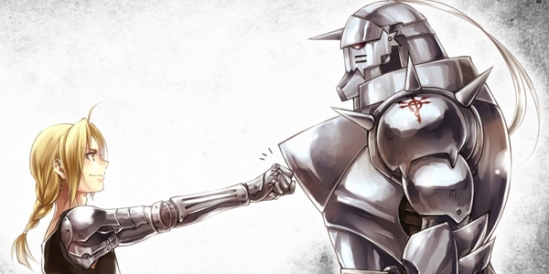
The shounen genre is one I really don’t like nowadays, as its tropes don’t really go that well with me, plus they tend to become really bad after a while. But as with everything in this world, there are exceptions, and FMAb is one of them! It took me a good 3 years before I actually got around to watching it. Unlike its peers, FMAb manages to have a really huge character cast that is actually really good. While not all characters get developed properly (obviously), their interactions with the characters that the author intended to develop were superb. The themes that FMAb dealt with were surprisingly mature for a shounen, and so was its execution. Unlike something like Akame ga Kill, it didn’t treat death lightly, nor did it have cartoonish villains. Even though I dislike the villain side of FMAb, at least they were developed and had personalities, and felt very humane. That doesn’t happen a lot, unfortunately, so it came as a nice surprise. The way the show treats the theme of war, in particular, appealed to me a lot, as it showed how people get traumatized even if they are in the winning side, the atrocities that it brings, the suffering… it was all done really well. I’d say that Edward, the main character, is not as good as some other shounen protagonists (or at least he didn’t appeal to me as much), simply because of his personality I guess, but he got better as the story moved on, it’s just that some characters outshined him, like Roy Mustang, my personal favorite in the anime.
Another thing I really digged was the ending, which was one of the best endings I’ve seen. It feels very rewarding and even emotional on a certain degree, as the characters that survived all find their peace of mind and try to move on with their lives. It’s one of those animes I wish I had watched earlier, but maybe I wouldn’t have appreciated it as much back then. With a length that is far inferior to some other mainstream shounen, it accomplished SO much more than them, constantly developing its characters and themes instead of falling into the “rule of cool” trap that the shounen genre loves to activate. It did have its tropes, especially when it came to the comedy, but to me it never really felt forced, it felt rather natural actually, and it was good that they kept it around even when the anime was in its later stages. With an amazing cast of characters and a really well thought out and executed story to boot, FMAb gets its deserved spot in the elite of this list.
//———————————————————————
#5 – Death Note

Ãh, re-watches. How I love them sometimes. Back in 2013, I used to watch anime purely for the rule of cool, and I was a bit edgy at the time, so the only thing that I cared about in Death Note at the time was Light going crazy and killing people. I used to think his ideal was quite right… how I’ve changed in these three years. I realized how much I was missing when I just focused on Light. Death Note actually has one of most subtle but efficient character cast I’ve ever seen. Whether its their ideals, personality quirks, interactions, everything is really good, and what makes it work is definitely how subtle they are, and how a short and casual interaction between two characters can end up being a mind game. As if the characters weren’t enough, the thrills that this anime gave me were beyond amazing, they without a doubt contributed to its high spot in my list. Whether it was the constant foreshadowing, the constant planning, the actual face offs, everything was SO intense, I was on the edge of my seat at all times even knowing what would happen, as I had watched the anime before. While I’ve re-watched a lot of anime before, none of them was as successful as Death Note, mostly because of how much I got from it despite having seen it before. The thing is, each scene seems to be built in a way that manages to deliver a powerful impact on the audience without relying solely on shock factor. That’s what separates Death Note from other shows that try too hard to impress me.
The usual problem people have with Death Note is the last third, which in my opinion is nowhere Near (get it?!) as bad as people say, or as I recalled it to be. As much as seeing L leave the scene was a hit to the quality of the show and my personal enjoyment, I have to admit the last third still felt like the first 26 episodes regardless, and a lot of twists and turns, plus some good new characters like Mikami were introduced. Death Note as a whole explores countless morality dilemmas. We humans don’t have an answer to the question “How do we stop crime, how can we stop evil in this world?”. Light’s approach is that people have to be fearful about a God judging them, and to be honest History does support that theory. At the same time, History also shows how people end up revolting anyway, so it’s just a temporary solution with no definitive answer. L thinks that isn’t the answer, and that realistically evil can only be stopped little by little, and using evil to stop evil is not worth it. I find L’s approach to be more desirable and realistic myself, as human nature can be controlled, but not stopped. It’s these kinds of ‘debates’ that made Death Note so good for me. While it does have some annoying scenes here and there (looking at you Misa…), as a whole, I can say that Death Note is a show that accomplishes what so many others couldn’t. And also, it’s the show that made anime in general popular in the West, so its significance and contribution to the medium is undeniable. It’s interesting how Death Note made me want to re-watch so many shows I watched back in 2012 and 2013, to see how much I’ve changed since then. It most definitely deserves its high spot in my list.
//———————————————————————
#4 – White Album 2

At the time of this article, I have not read the visual novel, so everything I say is JUST about the anime, for now anyway. If / When I read the visual novel, I might come back to this list and make the appropriate changes.
I used to despise White Album 2. The reason was simple: I hated everything in it. I didn’t understand what the characters were smoking to make such dumb decisions, I didn’t see any meaning or purpose in the story… I was a fool. When I rewatched it after one year and a half, with a completely different in general, it turned out to be one of the best experiences I’ve ever had with fiction. White Album 2 is similar to KimiNozu, in which there’s a love triangle and the main trio is developed by interacting with each other, but it’s not as dark as that one when it comes to its drama. In WA2, the tragic event happens not because of bad luck, not because there was an evil mastermind behind it, but because all the main characters inadvertently caused it to happen. Let’s face it – we all make bad decisions when we are young, we haven’t had the experience that adults have, and we learn by falling over and over and learning to get up. White Album 2 portrays this in a really realistic manner, and it really shows how these mistakes will end up destroying us inside eventually. It uses its first seven episodes for build-up, and I feel like these episodes are underestimated, because they were what made me care for the characters, it’s where the actual “seed” is. The next part of the anime is when the seed blooms: if the seed hadn’t been planted, you wouldn’t get a flower. The characters grow closer by training themselves for performing a concert in a festival, they ultimaely become the best of friends and everything seems nice… until they realize what they didn’t until then.
When the drama bits hit the scene, whether you will buy into it will have a lot to do with how you look at the build-up. I didn’t care for it the first time, so I hated it, but on my second watch I really liked it and payed attention to it, and found that EVERY single decision and mistake made was actually unavoidable, considering the circunstances. And it is in these dramatic moments that the characters learn what pain is. To have an unreachable love. To be betrayed. To be put in situations where there isn’t a right answer. The way the characters deal with their problems ends up making them destroy themselves even further, resulting in the really sad yet fulfilling ending that it has. The reason why I like WA2 so much is because it portrayed this situation flawlessly, it made me care for the characters, it had good scene execution, excellent music direction, and surprisingly mature writing. It was a really amazing experience when I finally got to rewatch it, and unfortunately there’s not much else I can talk about because there’s too many spoilers and I want to keep this spoiler free, but essentially the way the characters were handled is what makes it such a superb work. It’s short, it’s even somewhat controversial, but the lessons in it, and the fact that a lot of thought was put into it – that cannot be denied. And that’s the reason why it scores so high in this list, and why it’s one of the works I praise the most nowadays.
//———————————————————————
#3 – G-Senjou no Maou
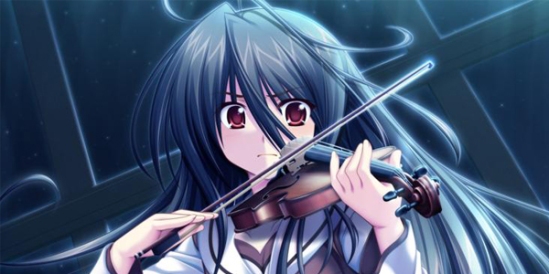
Devil on G-String was quite the experience for me. I read it right after Sharin no Kuni, and I was expecting something very similar because it’s the same studio and whatnot, but that wasn’t the case. Unlike the former, G-Senjou has a slower start, the first chapter takes its time building up the conflict and showing the characters and whatnot, but by the end of it I was actually quite hooked. What followed were two unimpressive side routes that I thought were decent, at the time, but in hindsight they were very inferior to Sharin’s. What makes G-Senjou score so high on this list is the main story. While there were side routes that were annoying and opened a plot hole for no reason, the main story (meaning, the story you get if you don’t enter any route and just keep reading it) is absolutely wonderful. You get to see Haru in every chapter doing her thing, going against Maou and his plans, and it’s really thrilling. Add those thrills to good music direction and soundtracks and you get some really amazing and memorable scenes. Kyousuke isn’t the most impressive main chracter at the beginning, unlike Kenichi, but he grows throughout the work and you’ll get to see why he acts like an asshole for a good portion of the story. Maou isn’t the kind of villain everyone will like but he stayed true to his purpose until the very end, and his goal, as far as I see it, was far from selfish, though I don’t condone his methods. I also liked he wasn’t one of those cheesy villains that is only there to create opposition to the main characters; instead he got a very good backstory and meaningful interactions with the rest of the main cast.
The best part of G-Senjou is definitely Chapter 5, the final one. In this chapter, pretty much every character that you thought was unredeemable was actually redeemed, somewhat, and I really liked how it all played out. I was constantly thrilled and wondering what would happen next, so much so that I ended up reading that chapter in one sitting. Everything made sense, and it came off as more than just shockfactor. The epilogue is what makes the work stand out in my list so much though, because it’s extremely sad and extremely beautiful at the same time, and was actually what made Kyousuke a really good main character in my eyes, coupled with his actions during the rest of the chapter. I feel like G-Senjou is the kind of story that pretty much anyone can enjoy, assuming you can get past the boring side routes (which honestly, were pretty much irrelevant, other than Mizuha’s which was pretty good), and the ending gave me a depression for the rest of that day, so yeah. Hurray for G-Senjou and AkabeiSoft 2!
//———————————————————————
#2 – Clannad: After Story

If there is a work that proved how emotions can be such a powerful thing, that’s definitely Clannad. While the first season didn’t offer anything particularly great, I enjoyed the main couple a lot, and I had great expectations from season 2, Afterstory. What I didn’t expect was what it did to me. In real life I’m pretty much an emotionless bastard, and I don’t even remember the last time I cried or even came close to when it comes to stuff happening outside of fiction, but damn Afterstory completely wiped me out. Now I’m not one of those rabid Clannad fans who will only praise the anime’s ability to make someone shed tears, because that’s underestimating it. In fact, Clannad has one of the most realistic and relatable main characters there are, Tomoya, as we get to see his struggle to get through life after graduation: we see him getting a job, living together with Nagisa, trying to overcome his shortcomings, and fearing change. This last aspect was particularly relatable to me, so I was quite fond of Tomoya by the end of the anime. As if the main character wasn’t enough, I also loved Nagisa because even though most think of her as a moeblob without personality, I tend to disagree a lot: she tries more than everyone else because she knows she’s weaker, and that’s where her power comes from. She manages to control her emotional stability very well, which complements Tomoya really well because he lacks this, and Tomoya is there to cover Nagisa’s own insecurities. They are my favorite couple in anime, and one of the very few who actually got married. Thematically, Clannad is a friggin treasure grove if you’re like me, and enjoy themes like nostalgia, moving forward with your life, coming of age, becoming a proper adult, etc.
As if these amazing characters and themes weren’t enough, the dramatic scenes are nearly flawless. First of all, the music direction is once again on point, and I really like that they saved the best pieces for the later part of Afterstory. The characters being relatable helps a lot because this is the kind of anime where liking the characters, or seeing them as human instead of pixels, is really a requirement for the drama to be believable; if you cannot do that, it will come off as melodramatic and stupid. Finally, these scenes aren’t known for making people cry because of how sad they are, but because they are beautiful. It gives us hope, a light at the end of the tunnel, and I thought that it was a really beautiful message to receive. One specific scene is famous for making the manliest of man shed a few tears, and that’s in episode 18 (of season 2). It’s an anime that I’ve been defending for almost four years now, and it’s one I will always consider to be my favorite no matter what. The ending is infamous for being bad, but if you use your brain and payed attention to the hints that were in both seasons, you should at least understand enough to admit it’s NOT an asspull. Granted this doesn’t mean you HAVE to like the ending, like I did, but at least accept it as something that makes sense in the context of the story. It does hurt the structure a little bit but not enough that is overshadows anything the anime accomplished before. So with a superb overall performance, Clannad is my favorite anime of all time, so hurray for Clannad and Key!
//———————————————————————
#1 – Rewrite

So after reading what I had to say about Clannad, you’re wondering what I could possibly like more than it. Well wonder no more, its name is Rewrite, and it’s the fictional work I hold dearest to my heart. Also made by Key, but not by the same author who did Air and Clannad, it’s the third Key work in the list. The author for Rewrite is actually the same who wrote Cross Channel: Romeo Tanaka, and this guy is a genius. Now Rewrite has everything I could possibly want in a work of fiction: themes that I constantly think about (ecology, how much time the planet will survive with us feeding off of it, personal relationships, how much someone can change the world alone), my favorite cast of heroines (with Lucia being my favorite, Akane a close second and the rest after), one of my favorite main characters in Kotarou (and he is what made me like Terra so much) and a really, REALLY nice ending. Now Rewrite’s pacing was the only thing that bothered me somewhat at some points, as the common route drags on and then Terra’s first half is slow and whatnot, but other than that, everything it has to offer is amazing. The heroine routes, if looked at individually, stand proud as some of the best routes in the medium because of how good the character development in them was. The main conflict of the story was the cherry on top of the cake, and it was what allowed that great development as well. It portrays many different ideologies and points of view on the world and on humanity, and it doesn’t try to sway the reader into one of them, but instead allows them to actually THINK about these matters. For fully enjoying Rewrite’s heroine routes though, you have to accept the mechanical problems that exist inbetween the routes – the reason for this is because there were three different authors, so some powers work a bit differently (in terms of mechanics) depending on the routes, but that doesn’t happen in the same route, so immersion is not broken. While most routes do not focus on the romance, the ones that did (Kotori and Lucia) were great at that, having some of my favorite romantic scenes in the medium as well. The fact that the routes were very varied in terms of genres was a concern to some, but to me it actually added to my enjoyment because it prevented the work from becoming boring and repetitive.
The most constroversial part of the work, and also the reason why it takes the number 1 in this list, is Terra. Moon, the route that precedes it, managed to set the ground for it very well. The main issues I hear with Terra are the pacing and the lack of heroines. While I did think the pacing could have been spread out better (because the first half was really slow and then the second one was much faster), that was only in hindsight – when I was reading it, I felt none of that. And as for the lack of heroines, three of them do show up, though in a different manner than you might think, and I thought it was better to develop the characters that had been “secondary characters” up until them, like Imamiya, Esaka and Touka, because this way we got a much better side cast in general. What made Terra so great for me was Kotarou and the ultimate message the route delivered to me. Which is “hope”. Rewrite does have a very pessimistic outlook on humans, and Terra straight out admits that the Earth will never survive forever and that the most we humans can do is try to preserve it for the longest time we can, and then we’d have to move to another planet. But what allows for this “hope” of making the Earth last is Kotarou, and his “journey through darkness”. I feel like I have to quote his last dialogue in the novel because it’s just beyond amazing: “At the very least, I hope that all the choices I’ve made while wandering through the darkness might give everyone a ray of Light”. This represents Terra and Rewrite extremely well, and Terra is basically Kotarou’s fight to save the world and, without him himself knowing, fulfilling the wish of his Moon self to see Kagari again. We see a different Kotarou this time around, who was influenced by the different choices he made (compared to those that led to the world of the common route and heroine routes), and who chooses to take action and defeat both organizations and give Kagari her good memories to avoid Salvation. I need to cut this short though, because I’m getting WAY too excited writing about it. Either way, Rewrite is and will forever be my favorite work of fiction, as I have an attachment to it that I find to be almost impossible to explain with words. So hurray for Rewrite for taking the number one spot in my list!
//———————————————————————
Thanks for reading!
